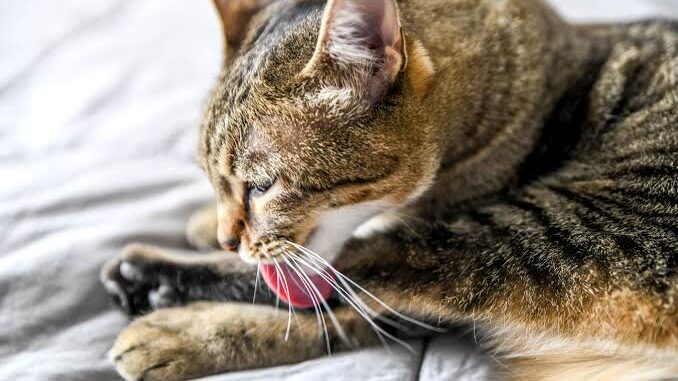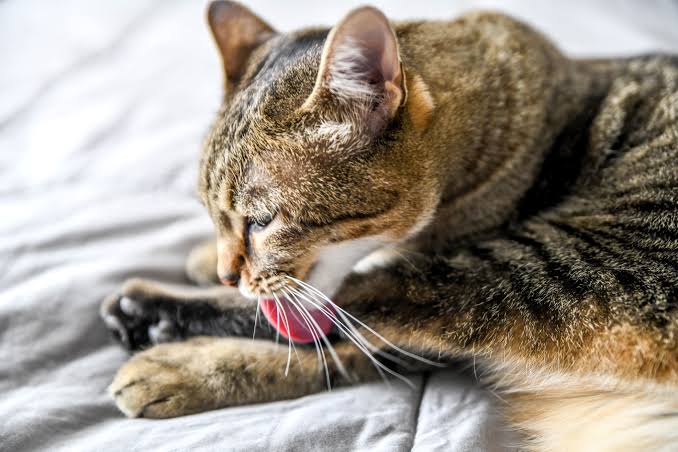
Reasons Your Cat Might Be Overgrooming: Cats are famously clean creatures. They spend a significant portion of their day grooming licking, nibbling, and smoothing their fur with surgical precision. But when this behavior becomes excessive causing bald patches, irritated skin, or compulsive licking your cat may be overgrooming, a symptom that shouldn’t be ignored.

In this guide, we’ll explore the top five reasons cats overgroom, how to spot the signs, and what you can do to help your feline friend.
What is Overgrooming?
Overgrooming is when a cat grooms excessively, beyond normal hygiene routines, to the point of:
- Fur loss or thinning (especially on the belly, thighs, or forelegs)
- Skin redness, wounds, or irritation
- Persistent licking, biting, or scratching
- Behavioral changes—such as anxiety or restlessness
This behavior is often a response to physical discomfort, psychological stress, or underlying health problems.
Reason 1: Allergies
How It Affects Cats
Just like humans, cats can develop allergies that affect their skin. The resulting itchiness or irritation prompts excessive grooming in an attempt to relieve discomfort.
Common Allergens Include:
- Food ingredients (like beef, dairy, or grains)
- Environmental allergens (dust mites, mold, pollen)
- Flea bites (even one bite can trigger a reaction)
- Household cleaners, fabrics, or perfumes
Signs of Allergy-Related Overgrooming:
- Itchy skin or frequent scratching
- Licking paws or belly compulsively
- Ear infections or head shaking
- Gastrointestinal symptoms (for food allergies)
What to Do:
- Visit your vet for allergy testing
- Try elimination diets for food-related causes
- Use hypoallergenic products in your home
- Apply vet-prescribed medications or antihistamines
Reason 2: Parasites and Skin Irritations
How It Affects Cats
Parasites like fleas, mites, or lice are some of the most common triggers of overgrooming. They cause itchiness, inflammation, and even allergic reactions, especially around the base of the tail, neck, and abdomen.
Common Parasites:
- Fleas – Even indoor cats can get them
- Mites – Cause mange or scabies
- Lice – Less common but possible
- Ticks – May trigger localized grooming or biting
Signs of Parasite-Related Overgrooming:
- Visible parasites or droppings (“flea dirt”)
- Patchy fur loss, especially on lower back
- Restlessness or irritability
- Sores or scabs
What to Do:
- Use flea preventatives (topical or oral) regularly
- Treat all pets in the household
- Clean bedding, furniture, and carpets
- Consult a vet for mite-specific treatments or allergy support
Reason 3: Stress or Anxiety
How It Affects Cats
Cats are creatures of routine. Changes in their environment or household can lead to psychological stress, which may manifest as overgrooming—known as psychogenic alopecia.
Common Stress Triggers:
- Moving homes or rearranging furniture
- New pets or people in the household
- Loud noises or construction
- Loneliness or boredom
- Lack of stimulation (especially for indoor-only cats)
Signs of Stress-Related Overgrooming:
- Fur loss in symmetrical patterns (especially belly, legs)
- Grooming mainly when alone or at night
- Lack of visible skin irritation or parasites
- Hiding, aggression, or changes in appetite
What to Do:
- Identify and minimize stressors
- Provide a safe space or hiding spot
- Use interactive toys and puzzle feeders
- Try calming diffusers (like Feliway)
- In severe cases, consult a vet for behavioral therapy or anxiety medication
Reason 4: Pain or Discomfort
How It Affects Cats
Cats may overgroom specific areas in response to internal pain, such as arthritis, injury, or urinary tract issues. Since they can’t vocalize their discomfort, grooming is a way to self-soothe or draw attention to the problem area.
Common Pain-Related Conditions:
- Arthritis (licking over joints)
- Bladder infections (grooming the lower abdomen)
- Post-surgical pain or wounds
- Dental pain (overgrooming the face or licking excessively)
Signs of Pain-Related Overgrooming:
- Grooming focused on one area
- Limping or reluctance to jump
- Hiding or growling when touched
- Behavioral changes like reduced play
What to Do:
- Visit the vet for a full physical exam
- X-rays or ultrasounds may be needed
- Pain management (NSAIDs, supplements, acupuncture)
- Supportive care like orthopedic beds
Reason 5: Skin Infections or Medical Conditions
How It Affects Cats
Skin infections—whether fungal (like ringworm), bacterial, or yeast-related—can cause itchiness and irritation. Over time, cats may worsen the infection through grooming.
In some cases, endocrine or autoimmune conditions also affect skin health.
Common Medical Causes:
- Ringworm – Fungal infection causing circular bald patches
- Pyoderma – Bacterial skin infection
- Hyperthyroidism or Cushing’s disease
- Autoimmune skin conditions
Signs of Infection or Medical Issues:
- Circular patches of hair loss
- Red, scaly, or oozing skin
- Bad odor
- Thickened or darkened skin
- Systemic symptoms (weight loss, increased thirst)
What to Do:
- Diagnostic tests (skin scrapings, cultures, bloodwork)
- Topical and oral medications as prescribed
- Isolate your cat if ringworm is confirmed (it’s contagious)
- Monitor for recurrence after treatment
READ ALSO: How to Train a Dog to Be Home Alone
How to Help Your Cat Stop Overgrooming
- Visit the Vet First:
Ruling out medical conditions is essential before assuming it’s behavioral. - Track the Grooming Behavior:
Record when and where your cat grooms excessively—it may reveal triggers. - Create a Calm Environment:
Use pheromone diffusers, reduce noise, and maintain consistent routines. - Provide Enrichment:
Bored cats may groom out of habit. Offer toys, climbing trees, and window perches. - Use Medicated or Hypoallergenic Shampoos:
Only with vet approval—bathing can help if skin conditions are present. - Consider Cone Collars Temporarily:
These prevent further damage but should be a short-term solution while treating the cause.
FAQs
How much grooming is considered normal for cats?
Cats typically spend 30–50% of their awake time grooming. It becomes a concern when you see bald spots, irritated skin, or obsessive licking.
Can overgrooming be cured completely?
Yes if the root cause is identified and addressed. However, behavioral overgrooming may require long-term management.
Is overgrooming painful for my cat?
It can be. Excessive licking and biting can lead to open sores, infections, and discomfort. It’s important to intervene early.
What if my vet can’t find a cause?
This may indicate psychogenic alopecia—a behavioral condition. A veterinary behaviorist can help with stress management strategies.
Can diet affect overgrooming?
Absolutely. Food allergies are a top cause of itchy skin. Switching to a limited-ingredient or hypoallergenic diet can sometimes resolve the issue.
Should I put a cone on my cat to stop grooming?
Only as a short-term solution while treating the underlying cause. Long-term cone use can stress your cat and doesn’t solve the root issue.
Can I use over-the-counter creams or treatments?
Avoid using human creams or medications. Always consult a vet some human products can be toxic to cats when ingested.
Are there any natural remedies for overgrooming?
Calming supplements (like L-theanine or CBD oil for pets) may help in some stress cases. However, never rely solely on home remedies without vet guidance.
Can indoor cats develop parasite-related overgrooming?
Yes. Fleas and mites can still enter your home on clothing, shoes, or other pets even if your cat never goes outside.
How long does it take for fur to regrow after overgrooming stops?
Fur regrowth typically starts within 2–6 weeks but can take months for full coverage. Age, breed, and health affect regrowth speed.
Leave a Reply
You must be logged in to post a comment.